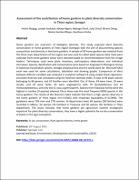| dc.description.abstract | Home gardens are reservoirs of biological diversity. This study assessed plant diversity
conservation in home gardens of Thies region (Senegal) with the aim of documenting species composition and diversity in the home gardens. A sample of 30 home gardens was
selected from the three main departments of the region and was used to collect plant species data. Data were collected from home gardens which were selected based on recommendations from the village leaders. Techniques used were plant inventory, participatory
observations and individual interviews. Species classifcation and nomenclature were
based on Angiosperm Phylogeny Group IV botanical classifcation system, Senegal analytical fora and the world plant list. Microsoft Ofce excel was used for some calculations, tabulation and drawing graphs. Comparison of efect between diferent variables was
analysed in analytical software R using simple linear regression, and plant diversity was
calculated using the Shannon diversity index. A total of 96 plant species belonging to 86
genera, and 43 families were identifed. Out of these, 34 were trees, 33 were shrubs, and
29 were herbs. 95 were angiosperms with 79 dicotyledonous and 16 monocotyledonous,
and only one (1) was a gymnosperm. Species from Fabaceae family were the highest in
number (9 species) whereas Citrus limon was the most frequent (80%) species in the home
gardens. The results of the Shannon index indicate that there is high species diversity in the
home gardens of Thies region (H1=3.9365) with moderate equitability (E=0.5968). The
gardeners were 73% men and 27% women. At department level, 66 species (38 families)
were recorded in Mbour, 54 species (33 families) in Tivaoune and 50 species (26 families)
in Thies department. The study indicates that home gardens are agriculture systems ecologically important for plant diversity conservation, they have a higher potential for ex-situ
conservation of plants in the agro ecosystem. | en_US |


